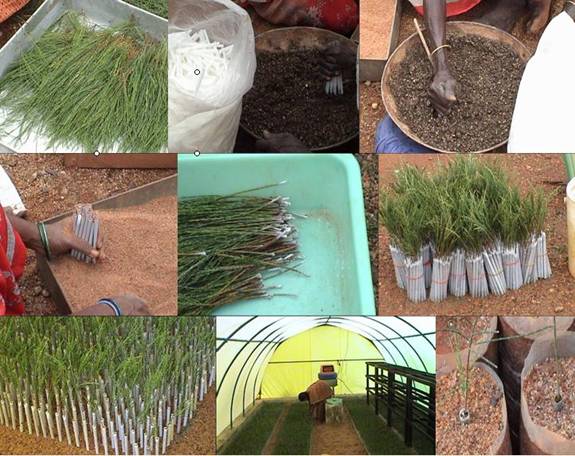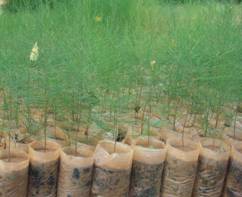
|
|||||||||||||||||||||||||||||||||
| Home | About Forestry | Eco-Tourism | Forestry Addresses | FAQs | Contact Us | |
|||||||||||||||||||||||||||||||||
| Forestry Technologies | |||||||||||||||||||||||||||||||||
NEW TECHNOLOGIES IN FORESTRYLatest Varieties/ Clones/ Technologies, FC&RI, Mettupalayam |
|||||||||||||||||||||||||||||||||
|
|||||||||||||||||||||||||||||||||
|
|||||||||||||||||||||||||||||||||
Special Features
Parentage: Clonal selection and multiplication Rotation: 30 -36 months Season: Planting during rainy season Yield: 100t/ha (wood) 33.3% increase over local type Highest yield obtained: 125t/ha (wood yield) Suitable areas: Scientists responsible for release
|
|||||||||||||||||||||||||||||||||
 |
|||||||||||||||||||||||||||||||||
Bamboos are the versatile trees, which flowers only in its cycle (40-60years) and dies what is popularly known as parthenogenesis. Hence, seed availability is very less at the same time the seed are less viable. This difficulty promoted bamboo propagation through two nodal culm cutting with rooting hormone treatment. This conventional techniques accounts only less than 25 percent success rate. The present technology is developed using entire culm without rooting hormone treatment and achieved 50 percent rooting. Remove one year old culm from the matured mother clump at 5-10 years growth stage. Care should be taken to remove the culm without damaging the culm as well as mother clump. The removed culm should be delimbed carefully by leaving growing buds in the nodes. Then, the culm should be placed it in the raised nursery bed and covered with loose soil and sand mixture for half inch thickness. After providing adequate shade to the culms in the nursery bed with coconut sheaths or rice straw, watering should be done to field capacity. Watering twice a day should be continued and shoot emergence will be observed after one month from all buds present in all nodes of the entire culm. Continue watering up to three months. The root emergence could be observed in 2-3 months. After rooting, the rooted culm should be removed entirely from the soil with out any damage. To facilitate uprooting the rooted culms with out damage, watering should be done. Each rooted node with shoots should be separated with small hand saw. The separated cutting can be transferred to poly bag. Benefits This is a very simple technique which can be easily followed by farmers with out help of technical experts Very simple and easy technology that can be confidently used for large scale multiplication of bamboo, because the success rate is more than 90 percent Since this technology does not involve any chemical treatment, it is notonly cost effective but also environmental friendly. In nut shell, this is the only simplest technology available to multiply bamboo on commercial scale Economics
Partial budgeting
Net gain using improved technology is Rs.12077/- (3 months duration in 52 cents of land) Scientists responsible for release
|
|||||||||||||||||||||||||||||||||
 |
|||||||||||||||||||||||||||||||||
| Home | About Forestry | Institutions | Biodiversity | Eco-Tourism | Forestry Addresses | Gallery | FAQs | Disclaimer | Contact Us |
|
|||||||||||||||||||||||||||||||||
| © All Rights Reserved. TNAU-2016. |
|||||||||||||||||||||||||||||||||
